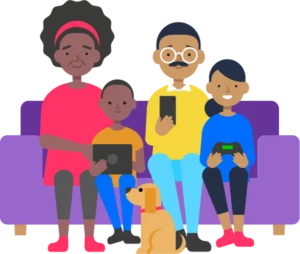Helen is a mum of two boys, Theo and Emerson, who are both autistic. They live near Brighton.
How do you introduce the topic of online safety with your children?
“We started talking about online safety quite early on,” says Helen, adding that they began using computers at a young age. “It’s been an ongoing conversation that’s changed as they’ve gotten older and as the types of games they play have changed.”
With the boys playing more interactively online, including with other people, these conversations have increased. “I often ask them to repeat back what they’ve understood in their own words,” she says. “That way, I can check if it’s really sunk in.”
“We talk about what boundaries are in place and how they need to be in control of what they’re viewing online.” Her eldest son sometimes seeks out content that upsets him, so she makes sure to talk about it impacts him. “We talk about the impact of what he’s watching and how algorithms can lead you to more dangerous content online. It’s about helping them understand when to draw back and know their limits.”
How do you handle abstract concepts like ‘stranger danger’ in online chats?
“We have a very strong rule that they can only play with people that they know,” says Helen. She highlights the importance of this as both boys are increasingly interested in playing online with their friends and using headsets to communicate. “We talk about how there are people online who might not be who they say they are and that they could be at risk if they’re not careful.”
But she also recognises that her sons might only know people online that they trust. “We’ve arranged to connect with them,” she says.
How do you manage opposite reactions to online safety rules?
“My boys are on different parts of the autism spectrum,” says Helen, “so their approach to online rules and online safety is very different.” She explains that her youngest will stick to rules they set because he is very rule-driven. However, her eldest likes to test boundaries. “So, we talk about why the rules are there and not just that these rules exist.”
Helen also uses a range of online safety tools for both of her children. “We use parental control apps like Google Family Link and Microsoft Family that help us set screen time limits, see what games they’re playing and how long they’re online.” She points out that these types of tools can help her start conversations around online safety and appropriate behaviour.
She’ll also check-in on the games her children are playing. “If we see they’re playing a certain type of game, we talk about it and make sure they’re not playing things that are beyond their level of comprehension.”
What advice would you give to other families with multiple neurodivergent children?
Helen stresses the importance of ongoing conversations to establish trust. She also warns against threatening to take away access to a device or platform. “If they think they’ll lose access, they won’t tell you what’s happening. Instead, we focus on setting reasonable boundaries, so they feel safe coming to us when they need to.”






